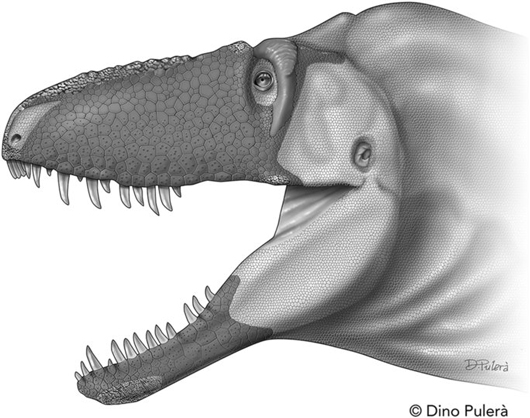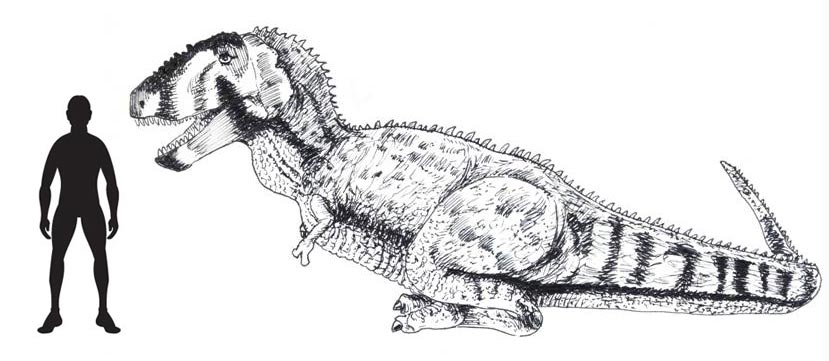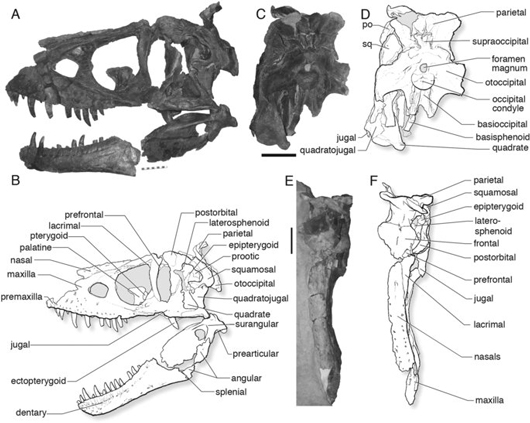Tyrannosaurids with Sensitive Snouts (Daspletosaurus horneri)
Scientists based in the United States have announced the discovery of a second species of Daspletosaurus, a member of the tyrannosaur family and analysis of the skull and jaws indicate that these carnivores, like crocodilians, had sensitive snouts.
The new species has been named Daspletosaurus horneri, “Horner’s frightful lizard”, the trivial name honours palaeontologist Jack Horner. John “Jack” Horner, was believed to be the inspiration for the character of Alan Grant in Michael Crichton’s novel “Jurassic Park”. From relatively humble beginnings, Horner established himself as one of the world’s most famous and eminent palaeontologists. In late 2015, he announced his retirement from the post of Curator of Palaeontology at the Museum of Rockies after thirty-three years in the post.
The Facial Features of Daspletosaurus horneri

Bone texture indicates large zones of large, flat scales and subordinate regions of armour-like skin. Integumentary sense organs occur on the flat scales that cover the densest regions of neurovascular foramina. The region outside of the crocodilian-like skin is reconstructed with small scales after fossilised skin impressions of tyrannosaurids.
Picture credit: Dino Pulerà
Daspletosaurus horneri and Daspletosaurus torosus
Fossils from an adult, a subadult and a lower jaw ascribed to a juvenile were found in close proximity in strata that forms the upper portion of the Two Medicine Formation (Montana). A phylogenetic analysis places this new tyrannosaurid as the sister species to Daspletosaurus torosus, named in 1970, when fossil material formerly associated with the genus Gorgosaurus was reassessed and assigned to a new genus. D. torosus is known from strata that dates from between 76.7 mya to 75.2 mya.
The fossils ascribed to D. horneri are found in slightly younger rocks, estimated to date from 75.1 mya to 74.4 mya. Given how closely related these two dinosaurs were, their geographical proximity and temporal succession, the researchers postulate that these two forms of Daspletosaurus represent a single anagenetic lineage.
An Illustration of Daspletosaurus (D. torosus)
Picture credit: Everything Dinosaur
The picture (above) shows an illustration based on the CollectA Age of Dinosaurs Daspletosaurus model.
To view the CollectA model range: CollectA Age of Dinosaurs Popular Range.
What is an Anagenetic Lineage?
Lead author of the paper, Professor Thomas Carr and his collaborators, argue that Daspletosaurus horneri evolved directly from its older, close relative Daspletosaurus torosus. This is a form of evolution known as anagenesis – one species gradually evolves over a period of time into a new species. An anagenetic lineage occurs when one population representing a single species, over thousands and thousands of years, gradually accumulates change. These changes eventually become sufficiently distinct from the earlier form that descendants can be labelled a brand new species.
The Skull and Jaws of the Daspletosaurus horneri Holotype
Picture credit: Scientific Reports
The picture above shows photographs and line drawings of some of the holotype fossil material (skull and jaws – MOR 590). Photograph (A) shows MOR 590 in left lateral view, (B) represents the line drawing of this fossil material. In photograph (C) an anterior view of the skull material is shown, (D) is the accompanying line drawing. Photograph (E) shows the skull in dorsal (top down) view, with (F), the line drawing of the top of the skull.
Sensitive Nerves on the Face of Daspletosaurus
Facial bone texture indicates a scaly skin, no sign of lips but a vast array of sensitive nerve openings (foramina). The researchers conclude that these foramina would have allowed hundreds of branches of the trigeminal nerve to reach the surface of the snout, turning the dinosaur’s face into a sensitive third “hand”.
The scientists, which include David Varricchio (Montana State University) and Jayc Sedlmayr (School of Medicine, Louisiana State University) compared these structures to the beaks of birds and the snouts of living crocodilians. Crocodiles and alligators have thousands of integumentary sensory organs around their jaws, the jaws help these reptiles to explore and understand their surroundings.
Commenting on the similarities between living crocodiles and the MOR 590 skull and jaw material, lead author Professor Thomas Carr stated:
“Given that the foramina are identical in Tyrannosaurs, [that] indicates that they had super-sensitive skin as well.”
The trigeminal nerve plays a special sensory role in many mammals, reptiles and birds, carrying sensory signals from whiskers and electrical receptors and enabling snakes such as the pit viper to home in on infrared radiation from warm-blooded prey. The snouts and jaws of tyrannosaurids could have been very sensitive, it has been speculated that these dinosaurs could have rubbed their faces together during courtship. Although, this is just speculation, similar behaviour is seen in extant animals today, so amorous tyrannosaurids could have rubbed their snouts together as part of bond forming or pre-mating rituals.
To read an article about potential courtship behaviour in theropod dinosaurs: Dance of the Dinosaurs.
Visit the award-winning Everything Dinosaur website: Everything Dinosaur.








Leave A Comment